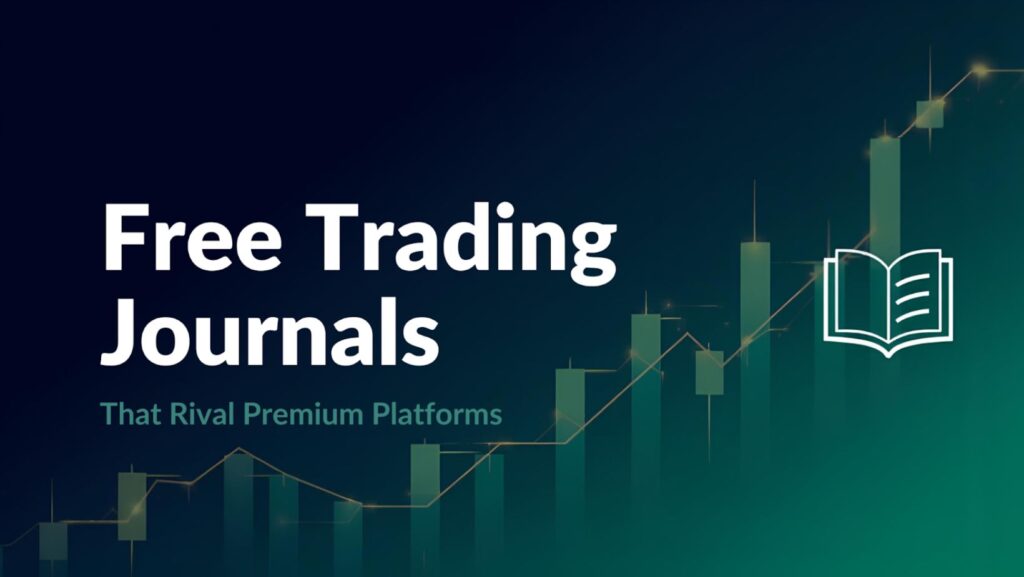Until fairly recently, if you were serious about your trading journal, you had to pay for it.
Advanced analytics capabilities, custom report generation, and broker integration were largely unavailable in free solutions.
But that’s changed.
There are several free trading journals that offer many of the same features, designs, and perceptions as paid journals.
These free journals won’t have all the fully featured functions of the top-end paid journals.
They will allow tracking performance, improving strategies, and developing consistency.
This is a list of free trading journals that compare to paid alternatives in several aspects.
Tradervue: Most Reliable Free Option with Professional Foundations
Tradervue’s free version is still the gold standard for traders who want professional infrastructure without committing to a paid plan.
Even at the free tier, this professional trading journal offers accurate imports from multiple brokers, clean trade summaries, and clear performance reporting that most competitors can’t match.
It automatically sorts your trades by setup name and symbol, calculates your profit and loss, shows your equity curves, and provides performance reports.
At any point, you can upgrade your account, and all your data will be preserved.
Strengths
- Free access to accurate trade imports and summaries
- Multi-broker compatibility and reliable reporting
- Proven track record with professional traders
- Perfect for testing before upgrading to premium
Weaknesses
- Advanced analytics and filtering reserved for paid users
- Interface focuses more on precision than design
- Limited customization on the free plan
Best for: Traders who want institutional-grade accuracy and structure without spending upfront.
RizeTrade: Best Free Journal for Day Traders and Fast Feedback
RizeTrade is a trading journal to give day traders time-stamped, session-based feedback on their entries, execution, and consistency to improve their trading.
It’s one of the very few free journals actually built for active, intraday trading.
Rather than just a generic daily trading journal, RizeTrade divides your day into pre-market, open, midday, and close sessions so you can see when you’re best.
This indicates to traders when they should apply the pedal and when they should pull back.
It’s fast, simple, and made to be used daily.
Tag your setups, log how you feel, and review how you performed in less than a minute.
One of the most useful free tools to help develop this consistency.
Strengths
- Session-based performance tracking built for day traders
- Quick journaling workflow that fits real-time trading
- Visual summaries for time-of-day profitability
- Free access to core tools with no forced upgrade
Weaknesses
- Fewer integrations than legacy platforms
- Advanced analytics and automation are still evolving
Best for: Active day traders who need structured feedback, not generic summaries, and who value speed and focus over complexity.
Trademetria: Most All-Round Free Journal for Consistent Tracking
The free plan at Trademetria is popular with new traders or those who trade part-time – it features just the right balance of functionality and analytics, allowing for keeping track of trades, tagging the setups, and trading performance across multiple accounts.
The reporting is far more basic than that of other paid solutions, but that simplicity provides an opportunity for traders to focus on building the right habits and discipline.
The dashboard simply shows win rate, profit/loss, and equity.
Strengths
- Functional free plan with multi-account tracking
- Intuitive interface that’s easy to learn
- Great for habit-building and consistent review
Weaknesses
- Advanced data breakdowns are limited to premium plans
- Minimal visual customization
- Lacks intraday analysis tools
Best for: Traders looking for a simple, structured way to log and review performance daily without getting overwhelmed by complexity.
Google Sheets: Most Free DIY Journal for Total Customization
In many cases, the best tools are the ones you create yourself, and Google Sheets continues to be one of the most flexible free trading journals around.
With a good template, traders can keep track of the entry/exit points, the risk/reward ratio, the profit of each individual instrument, the psychological aspects of the trades, and more.

Formulas, graphs, and conditional formatting may be used to achieve this.
It’s expensive at first, but once you build it out, it’s yours, and you have no restrictions whatsoever.
Strengths
- 100% free and fully customizable
- Allows unlimited creativity and control
- Easy to share or integrate with Google Scripts
Weaknesses
- No automation or broker import
- Requires setup time and spreadsheet skills
- Manual data entry can be tedious
Best for: Traders who enjoy customization, control, and building their own analytics workflow from scratch.
Notion: Most Free Platform for Organized and Reflective Traders
If you want a more functional and customizable journal, Notion is an excellent free tool.
It is not trading-specific, but it allows you to set up highly visual and organized types of journals.
You can log trades, upload screenshots, record emotions and write notes, or plan a strategy.
Many traders use Notion templates alongside screenshots from their charting services, such as TradingView, for an all-in-one review tool.
Strengths
- Free and completely customizable
- Combines notes, journaling, and planning
- Perfect for documenting emotional and strategic progress
Weaknesses
- Manual entry required
- Lacks automation and built-in analytics
- Setup takes creativity and consistency
Best for: Traders who view journaling as both a performance and self-development exercise, and who want to organize everything, trades, notes, and lessons in one place.
Free vs Paid: How Close Have Free Journals Come?
There was a time when free trading journals felt as if they were a lesser version of their premium counterparts.
Services like RizeTrade and Trademetria have a similar structure, analytics, and access that professionally built paid platforms have.
Tradervue fits between free and paid platforms, offering the infrastructure of a professional platform at no charge until you are ready to upgrade.
If you are technically inclined, Google Sheets or Notion also afford you total creative liberty: you can create your own fields, track the metrics you care about, and build a system that grows with your trading career.
Whether you prefer using a specialized journal platform or building your own from scratch, there’s no denying that journaling isn’t limited only to paid software these days.
Final Thoughts
You don’t have to pay to trade like a professional.
The best trading journals, whether paid software or simply free alternatives, exist to help you measure, reflect, and improve.
Start free RizeTrade, Trademetria, Tradervue. Just build the habit of logging trades first.
When you reach that level of consistency, you can determine whether more analytics are needed.
The data does not lie on a trading floor, but you have to collect the data.
The traders who do the analysis, the reviewing, and the changing of their plan make the money.

